| US Manned Spacecraft History And Photography |
STS-121 Discovery
Space Shuttle Launch
July 4, 2006
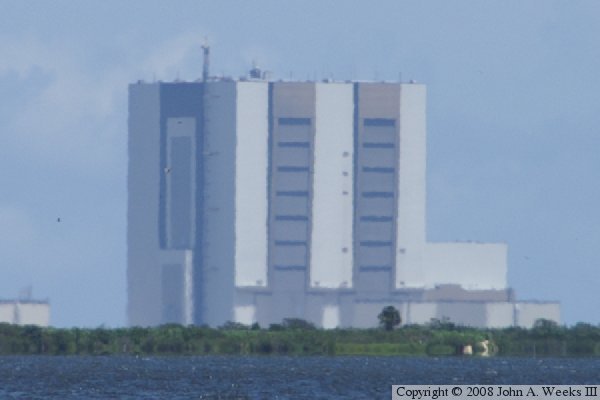
The vehicle assembly building is the third largest building in the
world by volume. At 525 feet tall, it was the tallest building in
Florida until it was surpassed in 1974. The VAB is impressively
large even at 8.9 miles in the distance across the Indian River.
The VAB is used to build the shuttle stack on the mobile launch pad.
The stack consists of the Discovery orbiter, an external fuel tank, and
two solid rocket boosters. The stack is carried out to launch pad
complex 39 using a crawler-transporter. Discovery was rolled out to
pad 39B on May 18, 2006.
If you look closely, you will notice a construction crane attached to
the left side of the VAB. This crane is part of a work project to repair
the VAB from damage done by two hurricanes that hit in 2004, Hurricanes
Frances and Charley. Over 1000 aluminum panels 10 foot by 40 foot in
size were blown off of the building. Some of these panels are intentionally
weak to allow them to blow off rather than causing damage to the building
structure.
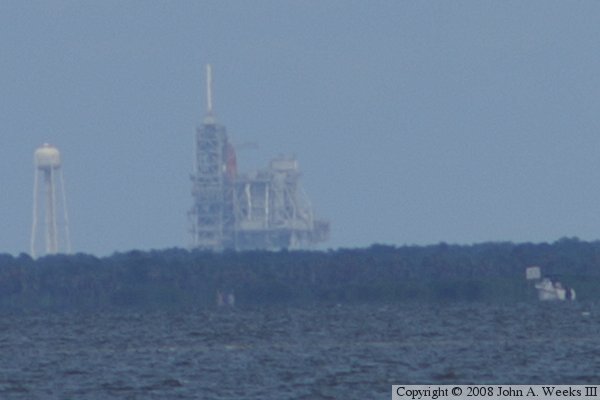
I hit the ground at 11:30AM on Saturday, July 1. I was out of the airport
in a rental car by noon. I then sat on the Florida Bealine highway for
over an hour getting through the first toll booth. Traffic was like that
all the way over to the coast. It finally let up when I got on US Highway
1, which is as close as anyone can get to the launch site without a special
NASA pass.
I arrived in Titusville about 4:15PM, with the launch scheduled for 4:48PM
(eastern time). The launch times were a little unusual for this flight
because the launch window was only about 10 minutes wide. This was due to
Discovery being launched to dock with the International Space Station, which
is in a high orbit. I parked at a Burger King, walked across the road, and
found a spot along the Indian River to view the launch. As near as I can
tell, this was about 11 miles from launch pad 39B.
The only part of the orbiter you can see from this vantage point is a
sliver of the brown external fuel tank. Discovery is obscured by the large
structure to the right of the launch tower. That structure is the rotating
service structure. It rotates in to provide a white room around the payload
bay to allow installation, testing, and servicing of cargo while the stack
is on the pad.
Right about 4:45, NASA announced that there was a lightning storm within
20 miles of the pad. While this probably would not impact the launch, it
would be a factor in the event of a launch abort. A pilot would not want
to have to land a crippled orbiter into a raging thunderstorm. I had just
successfully viewed my first launch scrub.

The next launch attempt was scheduled for Sunday afternoon on July 2.
A tropical low had developed over the lower Bahamas, and was feeding
thunderstorms into central Florida. The sky in this picture, taken at
the Melbourne, Florida, airport, says it all. NASA called a scrub right
about noon. Union rules state that launch site employees cannot work
three launch days in a row, so the next launch attempt would have to be
on Tuesday, July 4. This was my second successful launch scrub.
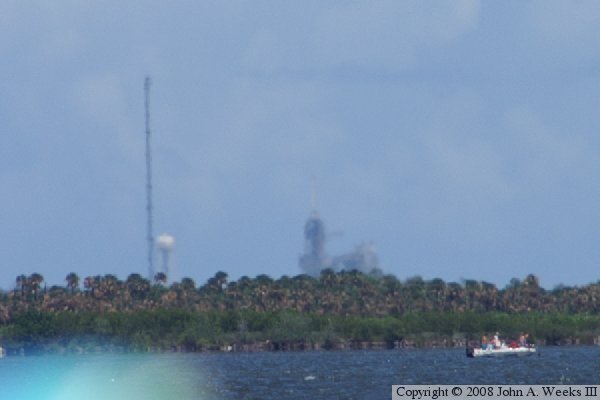
Here we are on July 4, 2006, in Titusville at the Space View Park. This is
probably the best place to view a shuttle launch, assuming that you do not
have a causeway pass from NASA. The launch is scheduled for 2:38PM. The
storms have died down, and the sky is pretty clear. That also means that
it is hot. Very hot. And humid. In fact, you can see that the air is
much more dense in that the pad is much less clearly defined in this photo.
The last 24 hours were nerve-wracking for NASA. The post-scrub inspection
revealed a crack in the foam, right in the problem area that has kept the
fleet grounded for much of the past 2-1/2 years. In order to view that
area of the external tank, scaffolding would have to be erected. If a
repair was needed, they might have to roll the stack back to the VAB, a
task that would take at least 12 days round trip. True to what we expect
from NASA, a technician found a way to rig a LED light and a CCD camera to
a broomstick, and that allowed engineers to inspect the foam crack without
erecting the scaffold, and a fix was implemented without a roll back. The
launch schedule was saved.
The last issue is wind. The wind had been gusting from 10 to 20 miles
per hour from over the ocean. This was not a launch problem, but it would
be too high of crosswinds in the event that the shuttle had to abort and
return to the landing strip at the Kennedy Space Center.
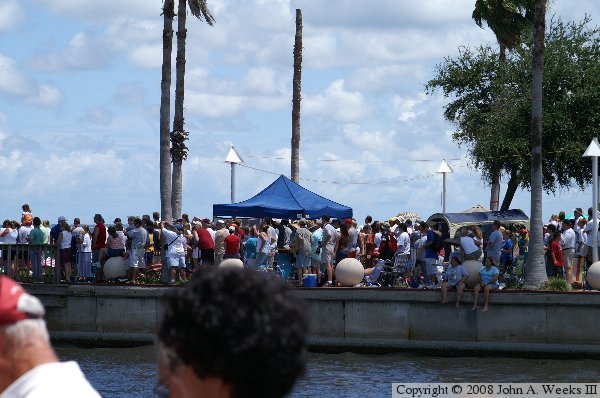
Titusville was packed. People were everywhere. The radio commentators
were saying that this was the largest launch crowd since John Glenn's
return to space in 1998 (which was also aboard Discovery). Space View park
is popular since it is one of the closest spots to the pads, and the group
that manages the park brings out loud speakers to carry the NASA commentary
during the launch.
With 5 minutes before the start of the launch window, NASA has just
announced that the weather is nominal (i.e., OK to launch), and the crosswinds
are just within limits. As a result, the final 9 minute countdown is
started. There really is only one major place in the count to hold, and
that would be at T-31 (31 second prior to launch). If they don't hold
at T-31, everything is on automatic from there on down. They will either
launch or abort.
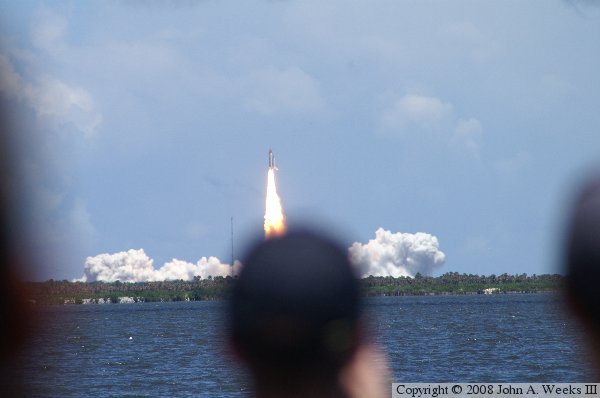
This is the typical result of a once-in-a-lifetime photo opportunity.
As the count went under 10 seconds, hundreds of people rushed down the
pier and crowed in front of all the folks who had staked out viewing
areas hours earlier. Just as I had the perfect shot, a head popped in
front of me, and that was that.
I could have been a bit more anal about getting more photos, and moving
in front of other people. But what I have found in the past is that I
get so wrapped up in the photos that I miss the event. In this case, I
was there for the event, and the photos were secondary. In addition,
the shuttle moves so fast that you have little time to think.
The white cloud on either side of pad 39B is steam, not smoke. The
rocket blast hitting the ground would cause sound reflections that would
damage the pad, destroy the orbiter, and likely break windows for up to
25 miles from the launch site. To solve this problem, NASA dumps water
on the pad starting at about T-6, and running to about T+15. In those
21 seconds, they dump 300,000 gallons of water from a water tower, plus
another 100,000 gallons of water in the piping. The rocket blast boils
this water, causing the huge steam clouds.
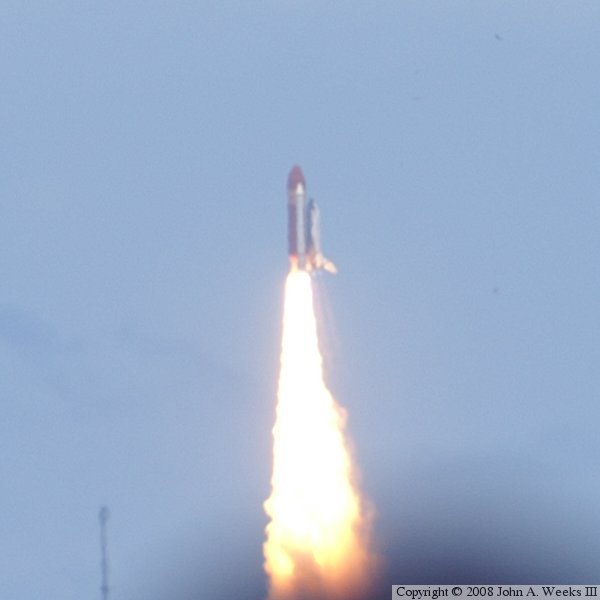
The space shuttle is fired from a blockhouse near the Vehicle Assembly
Building. They are about 3.5 miles from the pad. Once the shuttle clears
the tower, control of the flight is handed off to Houston. Houston is then
in control of the flight until wheels stop after landing. The first few
seconds of flight is straight up, with the object being to avoid hitting
the tower.
The bulk of the flame is from the external solid rocket boosters. They
burn a combination of ammonium perchlorate and aluminum mixed into a rubbery
material. The boosters weigh 200,000 pounds each empty, and hold 1.1-million
pounds of fuel. Once ignited, they cannot be turned off.
If you look closely under the rear of the orbiter, you can see two thin
lines of flame. That is the exhaust from the shuttle main engines. They
burn almost invisible compared to the flame from the solid rocket boosters.
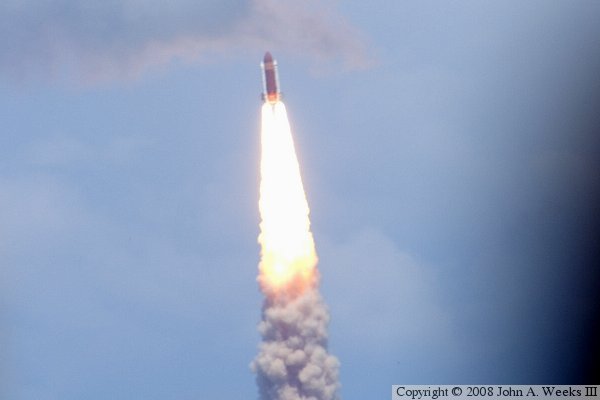
About 20 seconds into the flight, the shuttle starts two flight maneuvers.
First is the roll program. Since the pad cannot be rotated, and the shuttle
flies to orbits in different directions, the shuttle stack has to rotate just
after launch. In this case, the shuttle has to fly along the east coast of
the US in order to catch up with the space station. During the climb to
space, the orbiter is tucked under the stack to protect it from the airstream.
The other maneuver is that the path that the shuttle is flying is starting
to arc back towards the Earth. Since the shuttle flies parallel to Earth
when it is in orbit, it will have to make a full 90 degree arc as it climbs
into space.
The final activity is throttle down. The pressure of the wind on the shuttle
is greatest during the first minute of flight. To lessen the stress on the
shuttle stack, The three main engines are throttled back, then pushed up past
100% at about 75 seconds into the flight. In the case of STS-121, the cargo
is volume limited, not weight limited, so they were able to throttle back
to 67% power.
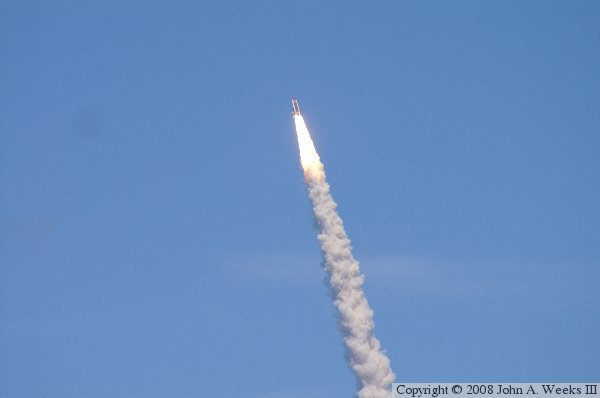
Here the shuttle is about 45 seconds into the flight. I recall it was
at about 3 miles high and a mile and a half downrange, just having broken
the speed of sound.
Up to now, the launch has been almost silent. That is because you see
the launch just as it happens (at near the speed of light), but the sound
takes a surprisingly long time to travel the nearly 12 miles from the pad.
First the sound starts as a low rumble, then a loud rumble as the solid
rocket boosters light up. As the shuttle climbs, the sound starts to
reflect off of the waters of the Indian River and Banana River, which
has the effect of amplifying the sound. The shuttle also snaps, crackles,
and pops as the solid rocket fuel burns.

About 70 seconds into the flight, the shuttle is around 9 miles high,
about 5 miles down range, and traveling at about Mach 2. At this time,
the call from the controllers is, "Discovery, go at throttle up." This is
where everyone holds their breath, remembering that this was the last
command sent to Challenger on that terrible day in January, 1986.
The shuttle stack has passed though the area of the highest dynamic
pressure, so it is OK to go to full throttle again. That is anywhere
from a throttle setting of 104% to 109%. How can they go over 100%?
The engines have been improved over the years, and they have been
qualified to fly at higher power levels. But no one ever went back
and reset the 100% mark.
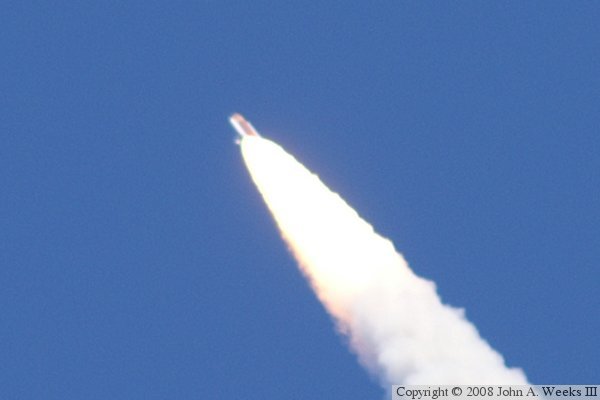
About 90 seconds after launch, the shuttle is really moving.
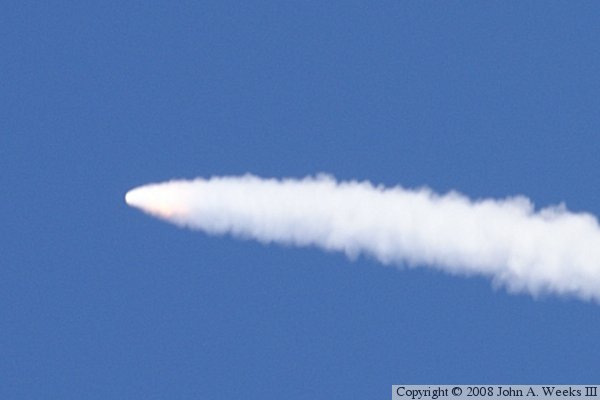
About 2 minutes into launch, the shuttle is hardly bigger than a dot in
the camera viewfinder. The solid rockets are starting to burn out, as
indicated by the smoke trail starting to thin out.
At 125 seconds into the flight, at an altitude of about 150,000 feet,
the solid rocket boosters will burn out and be ejected from the stack.
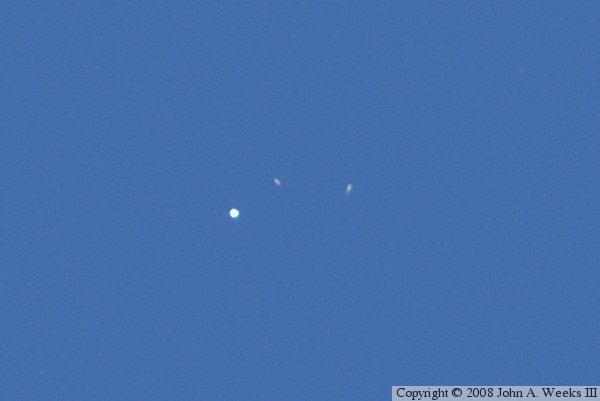
This photo is payback for the once-in-a-lifetime head shot earlier. The
shuttle was little more than a dot in the view finder. I knew that a photo
here would be little more than a pixel or two of white light. But I pushed
the button anyway. What I didn't know at the time is that I captured a
photo of the solid rocket boosters after SRB separation. You can see the
two SRB's flying just above and behind the big white dot that represents
the shuttle and external tank.
The SRB's will continue to fly a ballistic arc, reaching a maximum altitude
of 220,000 feet about a minute after separation. They will then rapidly
fall back to the Atlantic Ocean. With the flight path leading to the space
station, the SRBs will end up landing just offshore of Jacksonville, Florida.
They will be picked up by two boats, towed back to Cape Canaveral Air Force
Station, and then shipped back to Utah to be refilled for a future launch.
From here, the Discovery is past the vast majority of the atmosphere.
It will burn the three main shuttle engines for another 5 minutes or
so, which will result in a final speed of just over 17,000 miles per
hour and an altitude of around 300 miles. The main engines burn a
combination of liquid oxygen and liquid hydrogen. When the external
tank is empty, it will be ejected. The ET will reenter and burn up
over the Pacific Ocean.
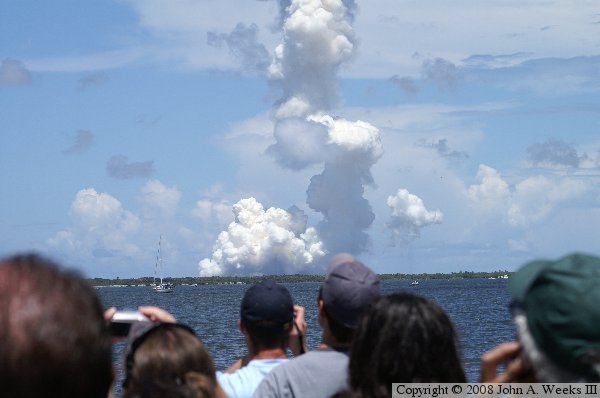
This is a photo of the smoke trail about a minute after launch. There
is still a huge cloud of steam around the launch pad. Wind is starting
to distort the path of the smoke from the solid rocket boosters.
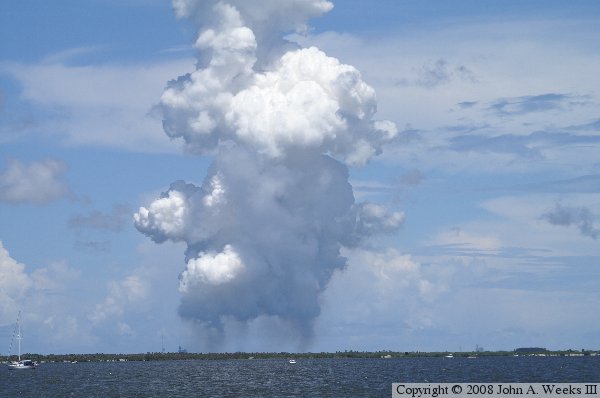
Another photo of the launch pad area, this time, about 3 to 4 minutes
after launch. Most of the viewers have left by now. The steam cloud
is rising, where it will eventually condense and fall as rain. The
solid rocket booster smoke is still hanging together, but the wind is
blowing it around, so it is already hard to make out the path that the
orbiter flew into space.
|

